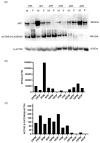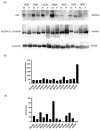The Interplay among Wnt/β-catenin Family Members in Colorectal Adenomas and Surrounding Tissues
- PMID: 39200196
- PMCID: PMC11352173
- DOI: 10.3390/biomedicines12081730
The Interplay among Wnt/β-catenin Family Members in Colorectal Adenomas and Surrounding Tissues
Abstract
Background: The colorectal adenoma undergoes neoplastic progression via the normal epithelium-adenoma-adenocarcinoma sequence as reported in the Vogelgram. The hazard of developing a tumor is deeply associated with the number and size of adenomas and their subtype. Adenomatous polyps are histologically categorized as follows: approximately 80-90% are tubular, 5-15% are villous, and 5-10% are tubular/villous. Given the higher risk of a malignant transformation observed in tubular/villous adenomas, patients diagnosed with adenomatous polyposis are at an improved risk of developing CRC. The Wnt/β-catenin pathway plays a key role in the onset of colorectal adenoma; in particular, intestinal cells first acquire loss-of-function mutations in the APC gene that induce the formation of adenomas.
Methods: Wnt/β-catenin pathway APC, Wnt3a, Wnt5a, LEF1, and BCL9 genes and protein expression analyses were conducted by qRT-PCR and western blot in 68 colonic samples (polyps and adjacent mucosa) from 41 patients, of which 17 were affected by FAP. Ten normal colonic mucosal samples were collected from 10 healthy donors.
Results: In this study, both the APC gene and protein were less expressed in the colon tumor compared to the adjacent colonic mucosa. Conversely, the activated β-catenin was more expressed in polyps than in the adjacent mucosa. All results confirmed the literature data on carcinomas. A statistically significant correlation between Wnt3a and BCL9 both in polyps and in the adjacent mucosa underlines that the canonical Wnt pathway is activated in early colon carcinogenesis and that the adjacent mucosa is already altered.
Conclusion: This is the first study analyzing the difference in expression of the Wnt/β-catenin pathway in human colorectal adenomas. Understanding the progression from adenomas to colorectal carcinomas is essential for the development of new therapeutic strategies and improving clinical outcomes with the use of APC and β-catenin as biomarkers.
Keywords: APC; BCL9; CRA; LEF1; Wnt/β-catenin; Wnt3a; Wnt5a; colorectal adenoma; early carcinogenesis; polyps.
Conflict of interest statement
The authors declare no conflicts of interest.
Figures





References
-
- Yang B., Mao L., Li Y., Li Q., Li X., Zhang Y., Zhai Z. β-catenin, leucine-rich repeat-containing G protein-coupled receptor 5 and GATA-binding factor 6 are associated with the normal mucosa-adenoma-adenocarcinoma sequence of colorectal tumorigenesis. Oncol. Lett. 2018;15:2287–2295. doi: 10.3892/ol.2017.7566. - DOI - PMC - PubMed
LinkOut - more resources
Full Text Sources
Miscellaneous

